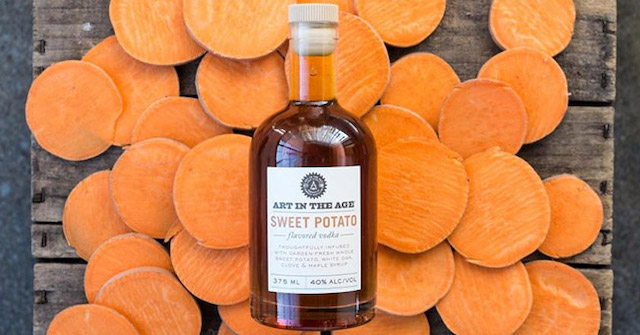When most people think of vodka, they think of the typical vodka bases — potatoes, wheat, even sugar cane in some instances — but there is one ingredient that is growing in popularity among craft distillers across the country: sweet potatoes.
Sweet potatoes aren’t new to the beverage world — for the past few years, sweet potato beers have been a steadily growing category, one that continues to grow year-by-year as more breweries work to incorporate a variety of ingredients into their beers. In addition, sweet potatoes also play a pivotal role in Shochu, which has roots dating back to at least the 16th century.
As far as distilled spirits in the United States go, though, sweet potatoes have been a relatively untapped market, with only a few distilleries using them — despite the fact that, as of 2015, 3.1 billion pounds were produced in the U.S. alone.
For Dave Souza, founder and distiller of California-based Corbin Cash, sweet potato farming runs in his family.
“My great grandfather immigrated to the U.S. from Portugal, where our family farmed sweet potatoes and raised cattle for generations. Sweet potatoes served two purposes for our family in the Azores,” Souza says. “One: it was a staple that would easily grow year round and stored well in cellars. Any extra could be used to feed the cattle which supplied us with meat and milk. Quite simply, when he came here, he grew sweet potatoes because that’s what we always grew.”
For NOLA Distilling, on the other hand, the move to use sweet potatoes was an obvious one, as they wanted to tap into an abundant ingredient around them in Louisiana.
“We wanted to find something that separated us from everyone else. We chose to go with Louisiana grown sweet potatoes because there were not a lot of other sweet potatoes on the market and they are a big cash crop in Louisiana,” Andy Kutcher of NOLA Distilling says. “I think if we lived somewhere else, maybe we would have tried something different.”
For the most part, sweet potato vodkas are produced in much the same way as other spirits.
“Using a proprietary process, the sweet potatoes are mashed, fermented and distilled through an alembic copper pot still. From there, my team and I taste each batch of spirits, making adjustments until they’ve achieved the distinctive character that sets Corbin Cash apart,” Souza says.
Taking a different tack, Tamworth Distilling and Mercantile, which produces Art in the Age spirits, uses their organic corn and rye base vodka, then adds sweet potatoes that are roasted whole.
“The base is then used as a medium to capture the flavors of sweet potato, clove and some oak chips for tannins. Maple syrup is then added for added woody sweetness. Our AITA line is considered flavored vodka, but the process and outcome is far more flavorful and has far more mouthfeel than typical flavored vodkas,” says Dierdre Maher, speaking for Art in the Age.
Nose, mouthfeel and flavor are important to distinguishing Corbin Cash and NOLA’s vodkas as well.
“Unlike other vodkas on the market, this one actually has a nose and a flavor. It’s got a very delicate earthy sweetness which all comes from the sweet potatoes,” Kutcher says.
Corbin Cash’s spirits also have a distinctive palate that separates them from other vodkas.
“Corbin has a viscosity most vodkas only have after chilling in the freezer. The vodka finishes with just the slightest residual sweetness that’s manifest naturally in the sweet potato. I’ve actually heard people from Northern Mexico compare the flavor to bacanora,” Souza says.
While there are not many producers of sweet potato spirits out there, there is hope for it to become a growing category (which would include, as Corbin Cash and NOLA already produce, gins made with a sweet potato base).
“We hope it’s catching on; it is a very unique flavor. Our approach to nearly everything we do is to try something different. We don’t have grampa’s old recipe, we aren’t tied to tradition. TDM really strives to explore new and different things, and we hope that other people see the interest in trying new things. That is the relationship that the craft beer world has fostered, and it makes sense to us to adopt the mantra for spirits,” Maher says.
That being said, Kutcher says that while sweet potato spirits will continue to grow, they’ll probably do so more as a subset of a bigger trend.
“I see a movement for ‘fresh and local’ more than a movement specifically toward sweet potatoes,” she says.
Souza agrees.
“Smaller-batch spirits with a unique flavor profile and a great story are definitely trending. Consumers, especially younger consumers, want to know where the things they eat and drink come from. The fact that we distill from crops grown on the farm my family has operated for a century checks a lot of those boxes.”





